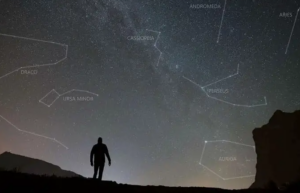Beneath the velvet cloak of the night, the universe unfurls its secrets in a celestial dance. This article embarks on a journey into the enchanting realm of stargazing, delving into its historical significance, the wonders it unveils, and the profound connection it fosters between humanity and the cosmos.

Eternal Gaze to the Heavens
Throughout history, humans have looked to the stars for guidance, inspiration, and a deeper understanding of the cosmos. Stargazing connects us to the timeless pursuit of knowledge and the unquenchable thirst for exploration.
Awe-Inspiring Constellations
The night sky becomes a canvas adorned with constellations that trace ancient stories and myths. These stellar arrangements serve as maps to navigate the vast expanse above and offer a glimpse into cultures that span the globe.
Stellar Time Travel
Every star in the night sky is a time traveler, its light journeying across light-years to reach our eyes. When we gaze at a star, we’re not just seeing its present state; we’re witnessing its history unfold.
Planetary Wonders
Stargazing unveils planets that twinkle like cosmic gems. Each world offers a unique glimpse into its individual characteristics, from the gas giants to the rocky landscapes and the potential for extraterrestrial life.
Meteor Showers – Cosmic Spectacles
Meteor showers grace the night sky with fleeting yet mesmerizing displays. These cosmic fireworks result from Earth’s passage through the debris left behind by comets, leaving streaks of brilliance in their wake.
Stargazing as Therapy
The act of stargazing is therapeutic, offering solace and a sense of perspective. The vastness of the cosmos puts life’s challenges into a broader context, igniting contemplation and reflection.
Telescopic Adventures
Telescopes bring distant wonders closer, revealing intricate details on planets, moons, and even distant galaxies. With each glimpse through a telescope, the universe’s complexity deepens.
Dark Skies and Preservation
Stargazing flourishes in areas free from light pollution. Efforts to preserve dark skies, such as designated dark sky parks, support the pursuit of clear, unobstructed views of the cosmos.
Astronomy and Cultural Unity
Stargazing unites people across cultures and borders. Regardless of language, nationality, or beliefs, the stars offer a common thread that links humanity in its shared fascination with the universe.
The Cosmos and Human Imagination
The stars have fueled human imagination, inspiring art, literature, and scientific inquiry. They kindle a fire of curiosity that drives us to explore the mysteries beyond our world.
Stargazing in the Digital Age
Modern technology allows for virtual stargazing, with apps and websites offering interactive guides to the night sky. This technological revolution democratizes access to the cosmos.
Legacy for Future Generations
Stargazing carries a legacy that spans generations. The wonder it imparts to young and old alike fosters an enduring appreciation for the beauty and grandeur of the universe.
Connecting Through Starlight
Stargazing bridges the gap between past, present, and future. When we gaze upon a star, we share the same view as our ancestors, transcending time and generations. The constellations that graced ancient skies still captivate modern eyes, reminding us of our shared journey through the cosmos.
The Universe Within Us
As we contemplate the stars, we’re reminded that the same elements that form distant galaxies also compose our bodies. We are, in essence, made of stardust, intricately linked to the universe on a fundamental level. Stargazing isn’t just an act of looking outward—it’s an introspective journey that connects us to the very origins of our existence.
Wrapping it Up – Conversations with the Cosmos
In conclusion, stargazing is a dialogue between humanity and the cosmos—a conversation conducted in the language of light and wonder. It teaches us humility, curiosity, and the realization that, in the grand tapestry of existence, we are but a small part of something infinitely greater.

